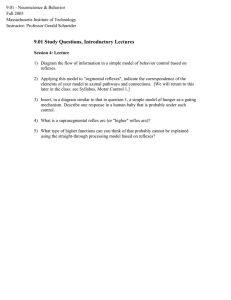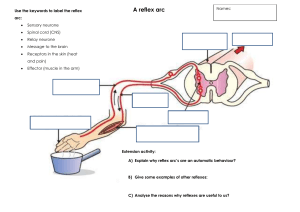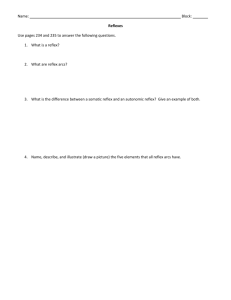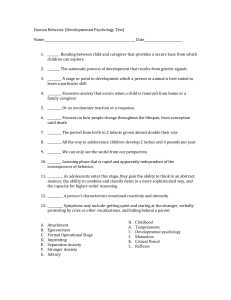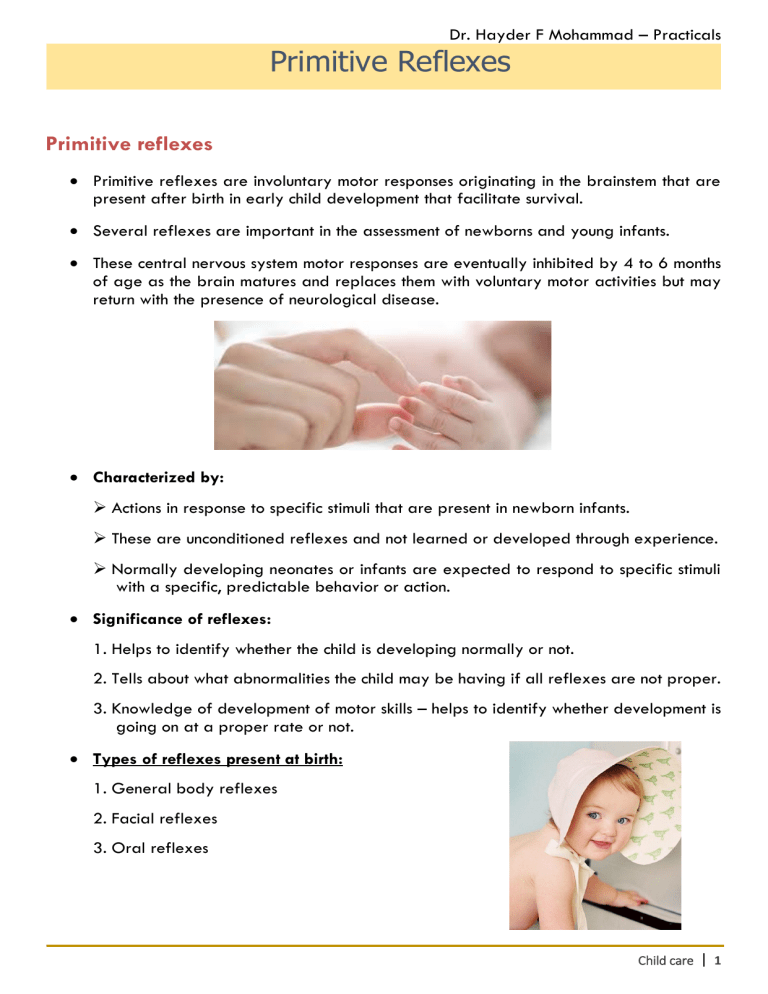
Dr. Hayder F Mohammad – Practicals Primitive Reflexes Primitive reflexes Primitive reflexes are involuntary motor responses originating in the brainstem that are present after birth in early child development that facilitate survival. Several reflexes are important in the assessment of newborns and young infants. These central nervous system motor responses are eventually inhibited by 4 to 6 months of age as the brain matures and replaces them with voluntary motor activities but may return with the presence of neurological disease. Characterized by: Actions in response to specific stimuli that are present in newborn infants. These are unconditioned reflexes and not learned or developed through experience. Normally developing neonates or infants are expected to respond to specific stimuli with a specific, predictable behavior or action. Significance of reflexes: 1. Helps to identify whether the child is developing normally or not. 2. Tells about what abnormalities the child may be having if all reflexes are not proper. 3. Knowledge of development of motor skills – helps to identify whether development is going on at a proper rate or not. Types of reflexes present at birth: 1. General body reflexes 2. Facial reflexes 3. Oral reflexes Child care | 1 General Body Reflexes A) Moro reflex/ startle reflex: Begins at 28 weeks of gestation. Initiated by any sudden movement of the neck. Elicited by -pulling the baby halfway to sitting position from supine & suddenly let the head fall back. Consists of rapid abduction & extension of arms with the opening of hands, tensing of the back muscles, flexion of the legs and crying. Within moments, the arms come together again. Clinical significance: Its nature gives an indication of muscle tone. Failure of the arms to move freely or the hands to open fully indicates hypotonia. It fades rapidly and is not normally elicited after 6 months of age. B) Palmar/grasp reflex: Begins at 32 weeks of gestation. Light touch of the palm produces reflex flexion of the fingers. Most effective way -- slide the stimulating object, such as a finger or pencil, across the palm from the lateral border. Disappears at 3-4 months. Replaced by voluntary grasp at 45 months Child care| 2 Clinical significance: Exceptionally strong grasp reflex -- spastic form of cerebral palsy & Kernicterus. May be asymmetrical in hemiplagia & in cases of cerebral damage. Persistence beyond 3-4 months indicate spastic form of palsy. C) Plantar/grasp reflex: Placing object or finger beneath the toes causes curling of toes around the object. Present at 32 weeks of gestation. Disappears at 9-12 months. D) Walking/stepping reflex: When sole of foot is pressed against the couch, baby tries to walk. Present at birth, disappears at approx. 2-4 months. Clinical significance: Premature infants will tend to walk in a toe-heel fashion while more mature infants will walk in a heel-toe pattern. E) Asymmetric tonic neck reflex: Most evident between 2-3 months of age. Clinical significance: The reflex fades rapidly and is not normally seen after 6 months of age. Persistence is the most frequently observed abnormality of the infantile reflexes in infants with neurological lesions. F) Babkin reflex: Child care| 3 Deep pressure applied simultaneously to the palms of both hands while the infant is in supine position. Stimulus is followed by flexion or forward bowing of the head, opening of the mouth and closing of the eyes. Fades rapidly and normally cannot be elicited after 4 months of age. Clinical significance: Reflex showing a hand-mouth neurological link, even at that early stage. G) Parachute reflex: Reflex appears at about 6-9 months & persists thereafter. Elicited by holding the child in ventral suspension & suddenly lowering him to the couch. Arms extend as a defensive reaction. Clinical significance: Absent or abnormal in children with cerebral palsy. Would be hemiplegia. asymmetrical in spastic H) Landau reflex: Seen in horizontal suspension with the head, legs & spine extended. If the head is flexed, hip knees & elbows also flex. Appears at approximately 3 months, disappears at 12-24 months. Clinical significance: Absence of reflex occurs in hypotonia, hypertonia or mental abnormality. Child care| 4 I) Trunk incurvation reflex: Stroking one side of spinal column while baby is on his abdomen causes. Crawling motion with legs. Lifting head from surface. Present in utero, seen at approximately 3rd or 4th day. Persists for 2-3 months. Facial REFLEXES A. Nasal reflex: Stimulation of the face or nasal cavity with water or local irritants produces apnea in neonates. B. Blink reflex: A bright light suddenly shone into the eyes, a puff of air upon the sensitive cornea or a sudden loud noise will produce immediate blinking of the eyes. C. Doll’s eye reflex (Oculocephalic reflex): Passive turning of the head of the newborn leaves the eye “behind” Oral Reflexes: A. Rooting reflex: Baby’s cheek is stroked: They respond by turning their head towards the stimulus. They start sucking, thus allowing for breast feeding. When corner of mouth is touched, lower lip is lowered, tongue moves towards the point stimulated. When finger slides away, head turns to follow it. When center of lip is stimulated, lip elevates. Onset -- 28 weeks IU. Well established – 32-34 weeks IU. Disappears – 3-4 months. Child care| 5 B. Sucking / Swallowing reflex: Touching lips or placing something in baby’s mouth causes baby to draw liquid into mouth by creating vacuum with lips, cheeks & tongue. Onset – 28 weeks IU. Well established – 32-34weeks IU. Disappears around 12 months. C. Cry reflex: Sporadic in nature. Starts as early as 21-29 weeks of IU life. Importance of cry: It is infant’s first verbal communication. Can be interpreted as a message of urgency or distress. Indicates: Hunger or Pain or Discomfort. Normal Growth Measurements Birth weight: 2.5-4.5 kg (average 3.5 kg). Length: 50 cm (average). Head circumference: 35 cm (average). Chest circumference: 35 cm (average). Pulse rate: 80 – 180 beats / min. Respiratory rate: 30-50 cycle / min. ** there are 2 major fontanels at birth (but sometimes 6 fontanels are present), these are anterior and posterior fontanel (Anterior closed at age of 9-18 month, while posterior closed few weeks after birth). Measurement of anterior fontanel about 3-5 cm in diameter. Child care| 6 Assessment Of Gestational Age Gestational age is determined by assessing various physical signs and neurological characteristics that vary according to fetal age and maturity. A. Rapid delivery room assessment The most useful clinical signs in differentiating among premature, borderline mature, and fullterm infants are (in order of usefulness): creases in the sole of the foot, size of the breast nodule, nature of the scalp hair, cartilaginous development of the ear lobe, and scrotal rugae and testicular descent in males. B. New Ballard Score. The Ballard maturational score has been expanded and updated to include extremely premature infants. It has been renamed the New Ballard Score (NBS). The score now spans from 10 (correlating with 20 weeks' gestation) to 50 (correlating with 44 weeks' gestation). It is best performed at <12 h of age if the infant is <26 weeks' gestation. C. Grading System for assessment of gestational age by examination of the anterior vascular capsule of the lens Child care| 7 Child care| 8
